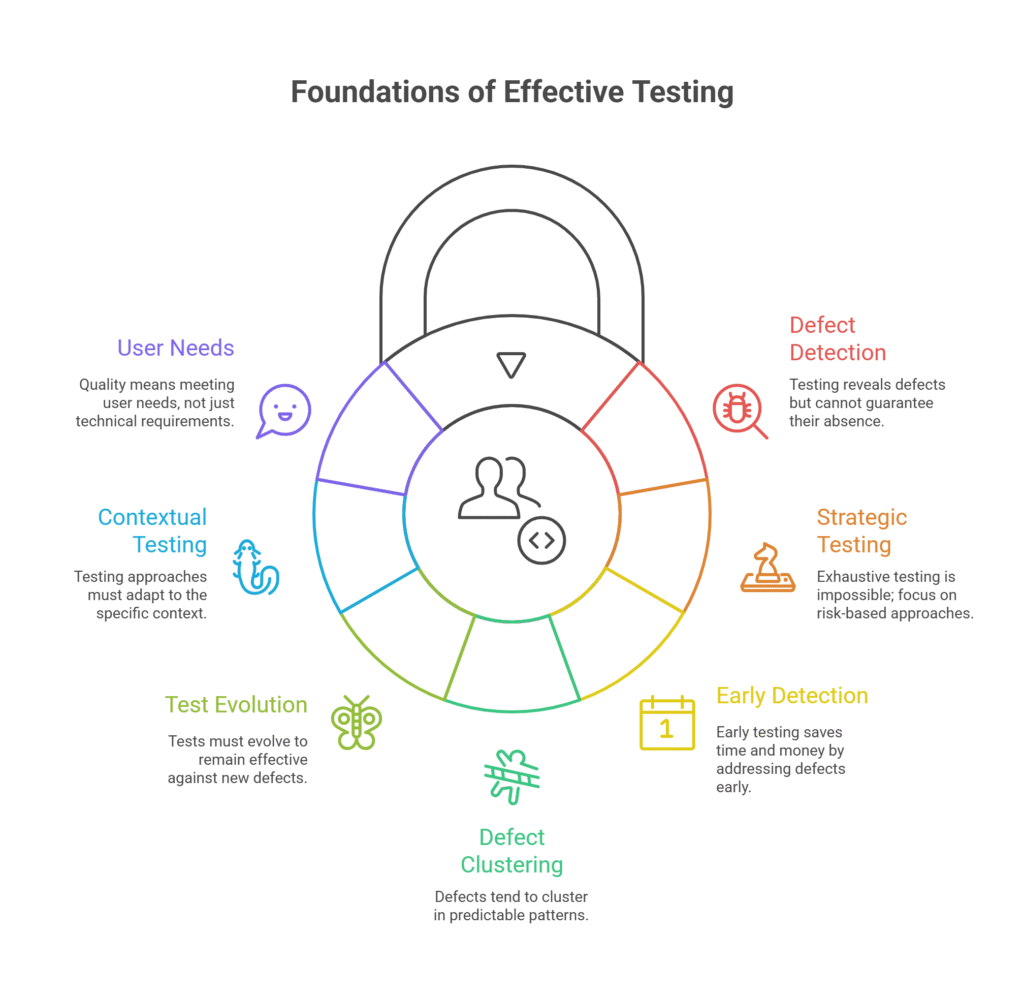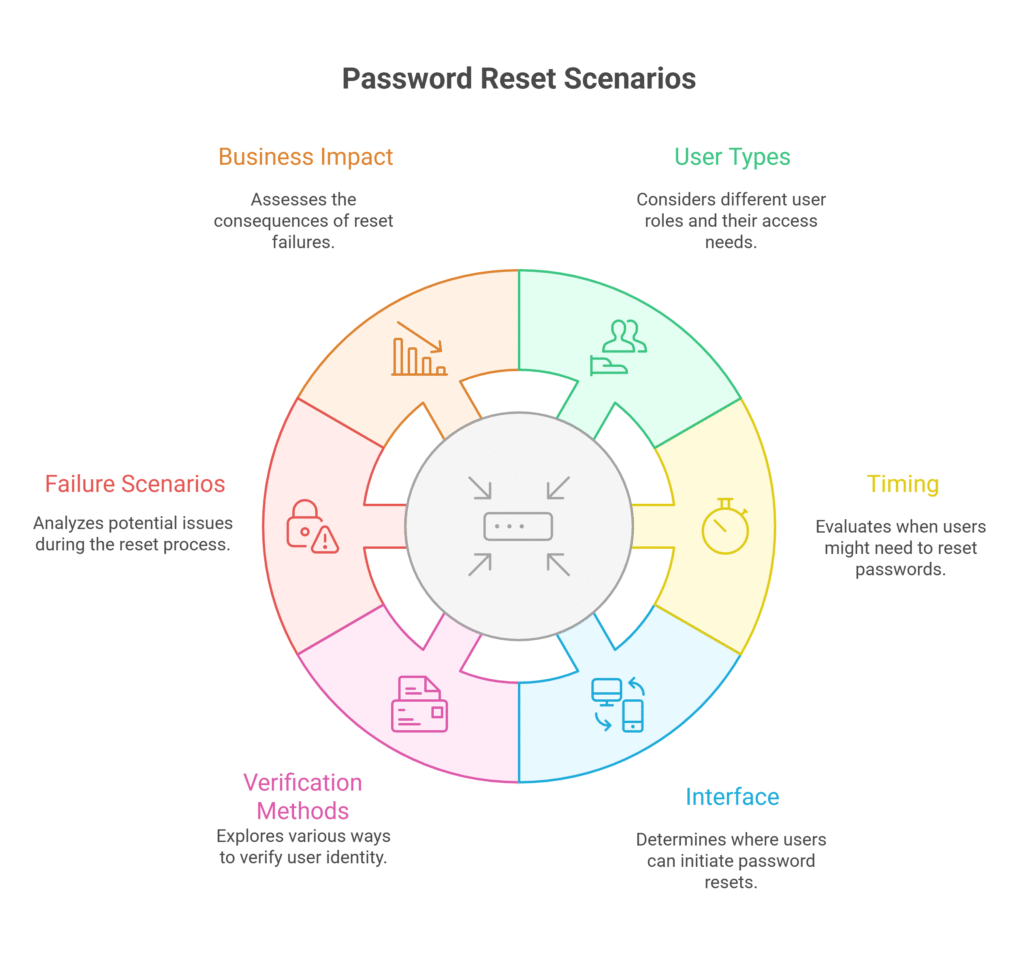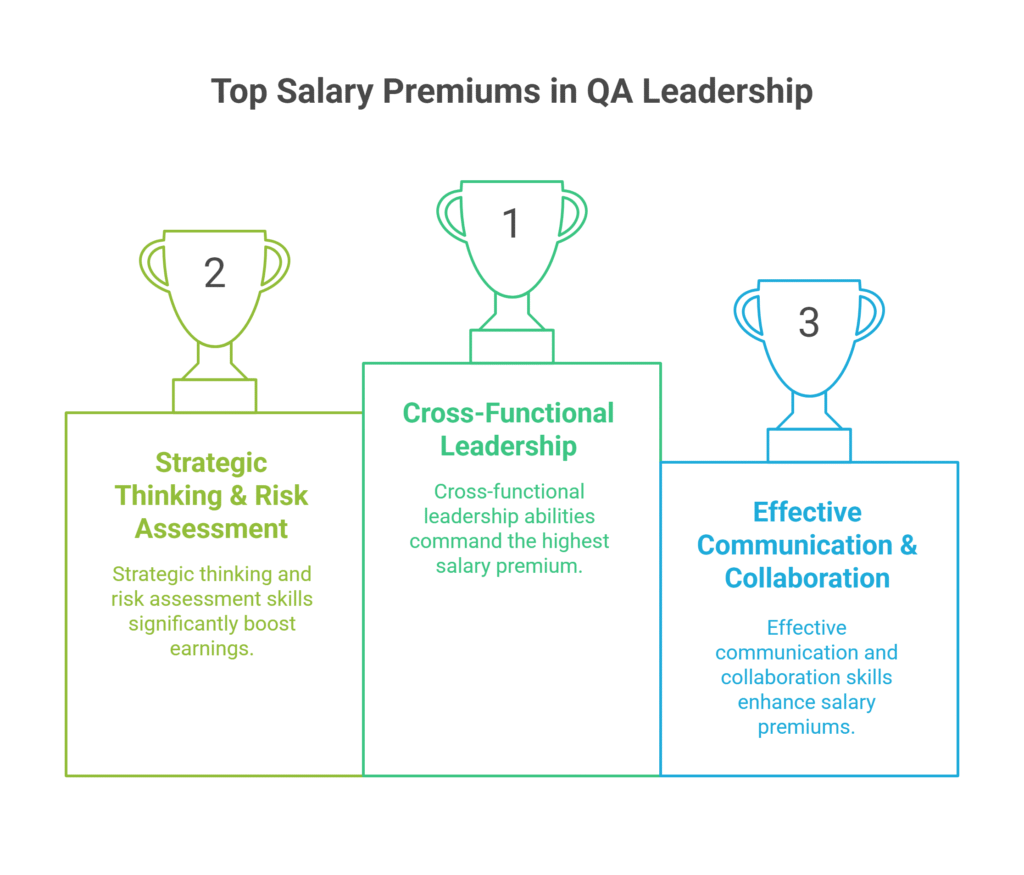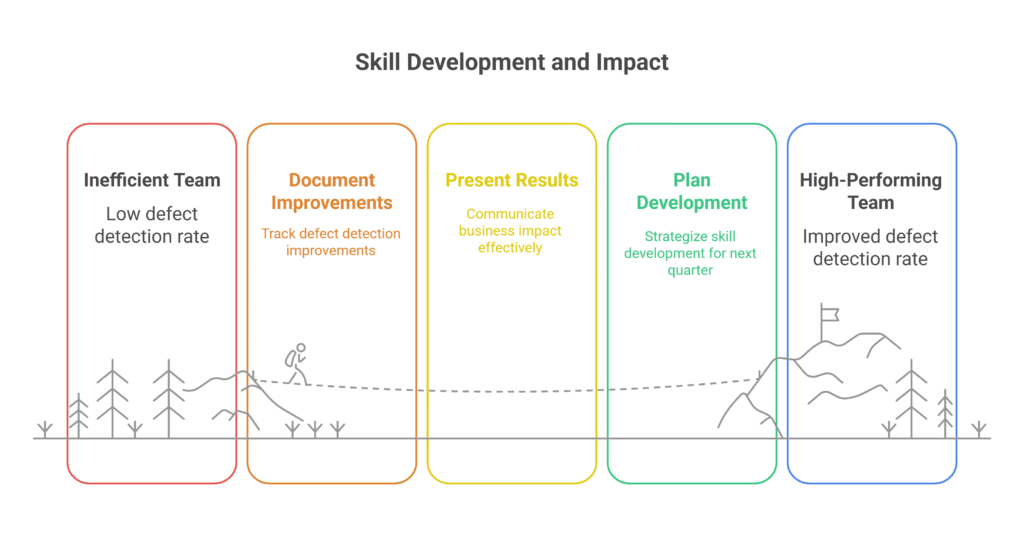The Foundation That Never Fades
Learning new technologies is crucial for staying competitive. Testing is evolving rapidly, with 86% of QA professionals now using automated testing and 74% of teams adopting at least two modern automation platforms in 2025. But here’s what industry surveys consistently show: the most successful testers aren’t those with the newest tools—they’re the ones who’ve mastered the timeless fundamentals that make any tool effective.
The uncomfortable truth? Many QA professionals are building their careers on shifting sand instead of solid rock. They can navigate the latest AI testing platform but struggle with basic requirement analysis. They can implement complex automation frameworks but miss critical edge cases that manual testing would catch. They know every feature of their testing dashboard but can’t write a bug report that developers actually want to fix.
This isn’t just my observation—it’s backed by data. Research from 2025 shows that teams with strong fundamental practices achieve 40% fewer production defects and 60% faster defect resolution times, regardless of their toolchain sophistication.
Let me share what truly separates great QA professionals from the rest, and why mastering these fundamentals will future-proof your career better than any trendy certification.
1: The Immutable Core of Quality Assurance
Understanding the Seven Principles That Never Change
Before diving into specific skills, we need to understand the foundational principles that govern all effective testing. These seven principles of software testing have guided quality professionals for over four decades and remain as relevant today as ever:

1. Testing Shows the Presence of Defects, Not Their Absence
This principle sets realistic expectations for what testing can achieve. No amount of testing can prove software is completely bug-free, but thorough testing significantly reduces the probability of defects reaching production.
2. Exhaustive Testing Is Impossible
With infinite possible test combinations, smart testers use risk-based testing approaches to focus efforts where they matter most. This principle drives the need for strategic thinking over brute-force testing.
3. Early Testing Saves Money and Time
Studies consistently show that fixing defects found in requirements costs 10x less than fixing the same defects in production. This principle underlies the entire shift-left movement in modern development.
4. Defects Cluster in Predictable Patterns
Experienced testers know that 80% of defects typically come from 20% of modules. Understanding clustering helps prioritize testing efforts effectively.
5. The Pesticide Paradox Demands Test Evolution
Running the same tests repeatedly becomes less effective over time. Tests must evolve to catch new types of defects.
6. Testing Is Context-Dependent
Banking software testing differs fundamentally from gaming software testing. Effective testers adapt their approach to the specific context and risks.
7. Absence-of-Errors Fallacy
Building bug-free software that users don’t want is still failure. Quality means meeting user needs, not just technical requirements.
Why These Principles Trump Tool Knowledge
Here’s what separates senior QA professionals from junior ones: senior testers use these principles to guide tool selection and testing strategy, while junior testers let tools dictate their approach.
Consider this real-world example: A startup I consulted with had invested heavily in an AI-powered testing platform that promised “intelligent test generation.” They were generating thousands of test cases automatically but still missing critical user journeys. The problem? They’d skipped fundamental requirement analysis (Principle 6: context-dependent testing) and weren’t applying risk-based prioritization (Principle 2: exhaustive testing is impossible).
After implementing proper requirement analysis and risk assessment processes—pure fundamentals—their defect detection improved by 65%, even while running fewer total tests.
2: The Essential Skills That Define Great Testers
Requirement Analysis and Critical Thinking: The Cornerstone Skills
Requirement analysis is where quality assurance truly begins, yet it’s often the most neglected skill in modern QA education. While bootcamps teach tool usage, they rarely teach the analytical thinking that determines what to test.
Effective requirement analysis involves:
Deep Questioning: Instead of accepting requirements at face value, great testers ask “Why does this requirement exist? What business problem does it solve? What happens if it fails?”
Stakeholder Mapping: Understanding who will use the feature, how they’ll use it, and what could go wrong during that usage.
Edge Case Identification: Using systematic thinking to identify boundary conditions, error states, and integration points.
Acceptance Criteria Validation: Ensuring requirements are testable, measurable, and complete before development begins.
Here’s a practical example of this skill in action:

Original Requirement: "Users should be able to reset their password"
Enhanced Analysis:
- WHO: All user types (admin, regular, guest accounts)?
- WHEN: During active sessions? After account lockout?
- WHERE: Web interface? Mobile app? Both?
- HOW: Email verification? SMS? Security questions?
- WHAT IF: Invalid email? Expired tokens? Multiple requests?
- BUSINESS IMPACT: What happens if this fails during peak usage?
The result? Instead of testing one happy path scenario, you’ve identified 15+ critical test scenarios that tools alone would never generate.
Test Design Techniques: The Systematic Approach to Coverage
Modern AI tools can generate test cases, but they can’t replicate the strategic thinking behind classical test design techniques. These methods have guided effective testing for decades because they’re based on mathematical principles and logical reasoning.
Equivalence Partitioning: Dividing input data into valid and invalid partitions to reduce test cases while maintaining coverage.
# Example: Testing age validation for insurance application
# Instead of testing every age from 1-120, use partitions:
invalid_partition_1 = [-1, 0] # Below minimum
valid_partition = [18, 25, 45, 64] # Valid ages
invalid_partition_2 = [121, 150] # Above maximum
# This gives complete coverage with 6 tests instead of 120
Boundary Value Analysis: Testing at the edges where most defects occur.
State Transition Testing: Mapping different system states and valid/invalid transitions between them.
Decision Table Testing: Systematically testing different combinations of conditions and their expected outcomes.
These techniques aren’t just academic exercises—they’re practical tools that consistently catch defects that random or tool-generated testing misses.
The Art of Exploratory Testing
While automation handles repetitive verification, exploratory testing remains uniquely human and irreplaceable. It’s the skill that separates testers from test executors.
Exploratory testing combines:
- Simultaneous learning, test design, and test execution
- Investigative skills to uncover unexpected behaviors
- Domain knowledge to test like real users would
- Creative thinking to imagine scenarios no one documented
A real example: During exploratory testing of an e-commerce checkout, a tester discovered that rapidly clicking the “Place Order” button while the payment was processing could create duplicate orders—a scenario no scripted test had covered, but one that cost the company thousands in refunds and customer service time.
This type of testing can’t be automated because it requires human intuition, creativity, and the ability to recognize that something “feels wrong” even when technical requirements are met.
3: Communication and Collaboration—The Multiplier Skills
Bug Reporting: The Bridge Between Discovery and Resolution
The quality of your bug reports directly impacts your career progression. I’ve seen talented testers stuck at junior levels because their poor communication made developers reluctant to work with them, while others advanced rapidly because their clear, actionable reports built trust across teams.
Effective bug reports include:
Clear, Specific Titles: “Login fails with valid credentials” not “Login broken”
Reproducible Steps: Detailed enough for any team member to replicate
Environmental Context: Browser, device, data state, user permissions
Business Impact: Why this matters to users and the business
Supporting Evidence: Screenshots, logs, network traces when relevant
Here’s a template that consistently produces results:
Title: [Component] - [Specific issue] - [Conditions]
Summary: One sentence describing what went wrong
Steps to Reproduce:
1. [Specific action]
2. [Specific action]
3. [Expected vs. actual result]
Environment:
- Browser/Device:
- User Type:
- Data State:
Business Impact:
- User experience effect
- Potential revenue/compliance impact
Attachments:
- Screenshot/video
- Console logs (if applicable)
Cross-Functional Collaboration: Quality as a Team Sport
Modern development is collaborative, and QA professionals who work in silos quickly become irrelevant. The most successful testers I know are those who’ve learned to be quality advocates, not quality gatekeepers.
This means:
- Joining planning sessions to influence design decisions early
- Pairing with developers during implementation to catch issues in real-time
- Working with product managers to understand user workflows and business priorities
- Collaborating with DevOps to build quality into deployment pipelines
- Training customer support to identify and report quality issues effectively
Career Impact: Testers who master collaboration skills become indispensable team members who get promoted to leadership roles, while those who focus only on technical skills often plateau as individual contributors.
4: The Modern Application of Timeless Principles
Functional vs. Non-Functional Testing: Comprehensive Quality Coverage
Functional testing answers “Does it work?” while non-functional testing answers “How well does it work?” Both are essential, but many modern teams overemphasize functional automation while neglecting critical non-functional aspects.
Functional Testing Fundamentals:
- Unit Testing: Individual component validation
- Integration Testing: Component interaction verification
- System Testing: End-to-end workflow validation
- Acceptance Testing: Business requirement fulfillment
Non-Functional Testing Categories:
- Performance Testing: Response times, throughput, resource utilization
- Security Testing: Vulnerability assessment, data protection validation
- Usability Testing: User experience and accessibility evaluation
- Reliability Testing: System stability under various conditions
- Compatibility Testing: Cross-platform and cross-browser functionality
The key insight: Tools can automate much of functional testing, but non-functional testing often requires human judgment, domain expertise, and contextual understanding that no tool can replicate.
API and Database Validation: The Hidden Foundation
While UI testing gets most attention, backend validation often provides better ROI and more reliable results. Modern applications are API-driven, making database and service-layer testing critical skills.
Essential backend testing includes:
API Contract Testing: Ensuring services communicate correctly
# Example API validation
curl -X POST /api/users \
-H "Content-Type: application/json" \
-d '{"name":"Test User","email":"test@example.com"}' \
# Validate: Response code, data format, business rules
Database State Validation: Confirming data integrity across operations
Performance Testing: API response times and throughput limits
Security Testing: Authentication, authorization, input validation
Test Environment and Data Management: The Foundation of Reliable Results
Poor test environments cause more failed automation than bugs in the application code. Yet environment management is often treated as an afterthought rather than a core skill.
Critical environment management includes:
- Environment Consistency: Ensuring test and production environments match
- Data Management: Creating realistic, privacy-compliant test datasets
- Configuration Control: Managing environment-specific settings
- Isolation: Preventing test interference between team members
- Monitoring: Detecting environment issues before they impact testing
5: Integration with Modern Development Practices
CI/CD and Shift-Left: Applying Fundamentals at Speed
Continuous Integration and Continuous Deployment aren’t just automation buzzwords—they’re the practical application of fundamental testing principles in modern development workflows.
Shift-left testing means:
- Requirement review before development starts (Principle 3: Early testing)
- Unit test creation during development (Principle 4: Defect clustering)
- Integration testing as components are built (Principle 2: Risk-based prioritization)
- Automated regression testing with every code change (Principle 5: Test evolution)
The fundamental skills that make CI/CD effective:
- Risk assessment to determine what tests belong in which pipeline stages
- Test design to create fast, reliable, maintainable automated checks
- Analysis skills to interpret test results and identify real issues quickly
- Communication to ensure the right people get notified about failures promptly
Agile and DevOps: Fundamentals in Fast-Paced Environments
Agile methodologies don’t eliminate the need for fundamental testing skills—they make those skills more important because there’s less time to recover from poor testing decisions.
In Agile environments, fundamental skills become critical because:
- Requirement analysis must happen quickly and accurately during sprint planning
- Test design must be efficient since testing windows are shorter
- Risk assessment becomes crucial for prioritizing limited testing time
- Communication must be more frequent and precise to keep fast-moving teams aligned
6: Career Development Through Fundamental Mastery
The Skill Progression That Leads to Leadership
Career progression in QA follows a predictable pattern based on fundamental skill mastery:

Junior Level (0-2 years): Focus on basic test execution and tool usage
- Master requirement reading and test case execution
- Learn fundamental testing techniques
- Develop basic communication skills
Mid Level (2-5 years): Develop analytical and design skills
- Master test design techniques and risk assessment
- Learn exploratory testing and critical thinking
- Build collaboration and mentoring abilities
Senior Level (5-8 years): Strategic thinking and cross-functional impact
- Master requirement analysis and stakeholder management
- Develop architectural thinking and system-level perspective
- Lead quality initiatives across multiple teams
Leadership Level (8+ years): Business alignment and organizational impact
- Master business analysis and quality strategy
- Develop team building and organizational change skills
- Drive quality culture and continuous improvement
The key insight: Every level builds on fundamental skills. Leaders who try to skip the basics inevitably plateau because they lack the foundation to make sound decisions under pressure.
Salary Impact of Fundamental Mastery
Data from 2025 salary surveys shows clear compensation premiums for QA professionals with strong fundamentals:
- Strong requirement analysis skills: 25% salary premium
- Effective communication and collaboration: 30% salary premium
- Strategic thinking and risk assessment: 40% salary premium
- Cross-functional leadership abilities: 50%+ salary premium
The reason: These skills are rare and directly impact business outcomes. Companies will pay significantly more for QA professionals who can prevent costly mistakes, improve team efficiency, and drive quality improvements across the organization.
7: Future-Proofing Your QA Career
Why Fundamentals Beat Tool Expertise
Here’s the uncomfortable truth about tool-focused career strategies: Tools change, but problems remain the same. The QA professional who builds their career around mastering specific platforms becomes obsolete when those platforms are replaced. The professional who masters fundamental problem-solving skills adapts quickly to any new tool.
Consider these technology shifts:
- 2010s: Selenium dominated automation (many testers became “Selenium experts”)
- 2020s: AI-powered platforms emerged (Selenium experts struggled to adapt)
- 2025+: Autonomous testing agents are emerging (tool-specific skills again become obsolete)
The professionals who thrived through every transition: Those with strong analytical thinking, communication skills, and systematic approaches to testing. They learned new tools quickly because they understood the underlying problems those tools were designed to solve.
The AI Era: When Fundamentals Become More Important
Artificial intelligence is changing testing, but not in the way most people expect. AI won’t replace human testers—it will amplify the capabilities of testers with strong fundamentals while making those without fundamentals less relevant.
Here’s why:
- AI can generate test cases, but can’t analyze requirements to determine what should be tested
- AI can execute tests, but can’t assess business risk to prioritize what’s most important
- AI can find bugs, but can’t communicate effectively with stakeholders about impact and urgency
- AI can process data, but can’t apply critical thinking to understand what the data means
The testers who will thrive in the AI era: Those who can direct AI tools effectively because they understand the fundamental principles of quality assurance.
8: Practical Implementation—Your 90-Day Fundamentals Plan

Month 1: Assessment and Foundation Building
Week 1-2: Skills Assessment
Honestly evaluate your current fundamental skills:
- Can you analyze requirements and identify missing information?
- Do you use systematic test design techniques or just ad-hoc testing?
- Are your bug reports clear enough that developers thank you for them?
- Can you explain testing decisions in business terms?
Week 3-4: Requirement Analysis Practice
Choose a current project and:
- Practice deep requirement analysis using the questioning framework provided
- Identify gaps, ambiguities, and untestable requirements
- Present findings to stakeholders and measure their response
Month 2: Skill Development and Application
Week 5-6: Test Design Mastery
- Apply equivalence partitioning and boundary value analysis to current test cases
- Measure improvement in defect detection compared to previous approaches
- Create decision tables for complex business rules
Week 7-8: Communication Enhancement
- Rewrite existing bug reports using the effective template provided
- Practice explaining technical issues in business terms
- Seek feedback from developers and product managers on communication clarity
Month 3: Integration and Leadership
Week 9-10: Cross-Functional Collaboration
- Volunteer for planning sessions and requirement reviews
- Propose quality improvements based on fundamental analysis
- Mentor junior team members using fundamental principles
Week 11-12: Results Measurement
- Document improvements in defect detection, team collaboration, and personal efficiency
- Present results to management using business impact language
- Plan next quarter’s skill development based on results
Final words: The Timeless Foundation of Quality Excellence
After more than a decade in quality assurance, I’ve learned that the most successful careers aren’t built on chasing the latest trends—they’re built on mastering timeless fundamentals that remain valuable regardless of technological change.
The tools will evolve. AI will become more sophisticated. Automation platforms will get smarter. Development methodologies will shift. But the core human skills—analytical thinking, systematic test design, effective communication, and collaborative problem-solving—will remain the foundation of excellent quality assurance.
The choice is yours: You can build your career on the shifting sand of tool expertise, constantly relearning new platforms to stay relevant. Or you can build on the solid rock of fundamental skills that make you valuable regardless of the technological landscape.
The professionals who master these fundamentals don’t just survive industry changes—they lead them. They become the senior testers, test leads, and quality directors who shape the future of their organizations. They earn the respect of their peers and the trust of their stakeholders because they consistently deliver results that matter.
Your next step is simple: Stop chasing the latest testing buzzword and start mastering the fundamentals that will define your entire career. The investment you make in these core skills today will pay dividends for decades to come.
Remember: Great testers aren’t defined by the tools they use—they’re defined by the problems they solve and the value they create. Master the fundamentals, and you’ll be prepared for whatever the future of quality assurance brings.
Key Takeaways
- Fundamental skills trump tool expertise for long-term career success and adaptability to industry changes
- The seven principles of testing provide a timeless framework for making effective quality decisions regardless of technology
- Requirement analysis and critical thinking are the most valuable skills that separate great testers from good ones
- Communication and collaboration abilities create career advancement opportunities and salary premiums
- Systematic test design techniques consistently catch defects that random or tool-generated testing misses
- Mastering fundamentals prepares you for the AI era by developing skills that complement rather than compete with automation
Frequently Asked Questions
What are the most important QA fundamentals that every tester should master?
The most critical fundamentals include requirement analysis and critical thinking, systematic test design techniques (equivalence partitioning, boundary value analysis), effective communication and bug reporting skills, exploratory testing abilities, and cross-functional collaboration. These skills form the foundation that makes any testing tool or methodology more effective.
How do fundamental QA skills help with career advancement and salary growth?
Strong fundamental skills lead to measurable career benefits including 25-50% salary premiums, faster promotions to leadership roles, and better job security during industry changes. Professionals with excellent communication, analytical thinking, and strategic skills become indispensable team members who get promoted while tool-focused testers often plateau at individual contributor levels.
Why are QA fundamentals more important than learning the latest testing tools?
Fundamentals provide the analytical framework needed to use any tool effectively, while tool-specific knowledge becomes obsolete as technology evolves. Testers with strong fundamentals adapt quickly to new tools because they understand the underlying problems those tools solve, while those focused only on tool expertise struggle when platforms change.
How can I improve my requirement analysis and critical thinking skills as a QA professional?
Start by practicing deep questioning techniques during requirement reviews, asking “why” behind every requirement and identifying edge cases systematically. Use structured analysis frameworks to map stakeholders, business impacts, and failure scenarios. Volunteer for planning sessions and requirement discussions to get more practice, and seek feedback from product managers and business analysts on your contributions.
What’s the difference between functional and non-functional testing, and why do both matter?
Functional testing validates that features work as specified (testing the “what”), while non-functional testing evaluates how well the system performs under various conditions (testing the “how well”). Both are essential because users need software that not only functions correctly but also performs well, remains secure, and provides a good user experience. Many teams over-focus on functional automation while neglecting critical non-functional aspects.
How do QA fundamentals apply in modern Agile and DevOps environments?
Fundamental skills become even more critical in fast-paced environments because there’s less time to recover from poor testing decisions. Quick requirement analysis during sprint planning, efficient test design for shorter testing windows, effective risk assessment for prioritization, and clear communication for fast-moving teams all depend on solid fundamental skills rather than specific tool knowledge.
QABash Nexus—Subscribe before It’s too late!
Monthly Drop- Unreleased resources, pro career moves, and community exclusives.
